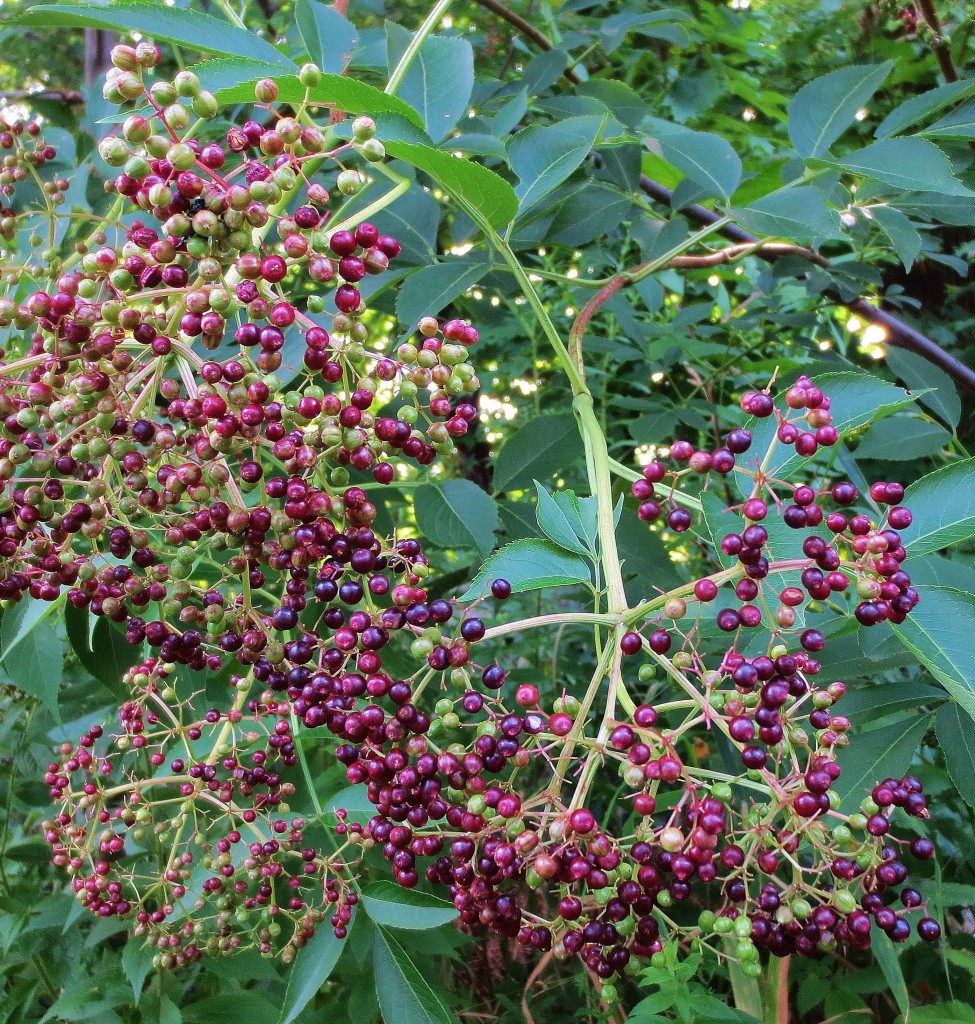
Foraging for Elderberries: How to identify, where to find it, and how to harvest the berries. Detailed photos for ID.
The American elderberry, Sambucus canadensis, also called common elderberry or wild elder, is native to eastern North America. It is sometimes considered to be the same species as Sambucus nigra, the European elderberry or black elderberry. The two are at least very closely related. Because this common roadside shrub is relatively easy to find and the berries and flowers are easy to harvest and prepare, foraging for elderberries is popular among wild food enthusiasts.
Common elderberry bears a profusion of edible flowers and berries. The berries are high in vitamin C and cancer fighting antioxidants (Thole, et al., 2006, Journal of Medicinal Food). There is little Sambucus canadensis in cultivation in the US, but this is changing as interest in its health benefits grows, and cultivation of Sambucus nigra is already common in Europe.
Although both flowers and ripe berries are edible and nutritious, all other plant parts are toxic, so be sure to pick over your harvest and remove all leaves, twigs, and stalks. Now this doesn’t mean that every speck of leaf or twig visible to the naked eye will make you sick. Pick out as much as you can and use common sense.
I pick elderberries almost every August, because there is a huge roadside clump of it right across from my house, and many smaller clumps along my daily walking route. Harvesting them couldn’t be easier or more convenient, and foraging is cheaper than shopping.
General description of Sambucus canadensis
American elderberry is usually a spreading shrub that reaches about 10 feet in height, here in Massachusetts. It can grow to 12 or 13 feet in the southern portions of its range. I have read that it can grow as a small, single trunked tree, but all specimens I’ve encountered are shrubs
The leaves are oppositely arranged on the twigs. Each leaf is composed of an odd number of toothed, oval leaflets. There are typically 5-9 leaflets, but occasionally as many as 11.
American elderberry flowers
The lacy clusters, composed of many tiny white flowers, bloom in mid-late June here in central New England. Once you have developed a search image in your mind for the shrub in bloom, look around for the flower clusters as you travel about in spring. This is an excellent way to map out foraging opportunities, whether you are after flowers or berries. If you pick the flowers, though, less fruit will be produced. I leave the flowers and wait for the berries.
Berries of Sambucus canadensis
Here in central New England, the tiny berries (about 3/16 inch in diameter) ripen in mid-late August, to a deep purple-black color. They’re borne in clusters at the ends of twigs. Often, some of the berries in a cluster will be ripe when others are still greenish.
I usually harvest them by gently rubbing the clusters between my fingers, allowing the berries to fall into a basket. But entire clusters break easily from the twig, so if the weather is unpleasant, I fill a basket with whole clusters and retire to a more comfortable spot for removing berries from stalks.
However you do it, be sure to pick them over and remove any plant matter other than ripe berries. You’ll have less picking over to do, if you wait until the whole cluster is ripe, but I find that if I wait that long, the birds get most of the berries.
Where to forage for elderberries
Common elderberry is native to eastern North America, but it has naturalized in some of the western states. So, its range map now includes much of the continent. It prefers fertile soil which is moist but well drained. It likes good sun exposure, so look for it in open areas. You’ll find it in ditches along the side of the road, and at field and wetland edges. If you live in a densely populated area or manicured suburb, you’ll probably have to seek out a more unruly landscape to find this plant. I live in a semi-rural town with few sidewalks, and American elderberry is quite common along the narrow roads and hayfield edges.
Preparing and eating elderberries or elderberry flowers
The flavor of the raw, ripe berries is somewhat reminiscent of blackberries, but not as juicy or flavorful. Cooking them greatly improves and intensifies the flavor. Raw berries can be dried and later cooked, or fresh berries can be boiled to make delicious juice, syrup, jelly, and jam. My favorite in the jelly/jam category is Seedless Elderberry Apple Jam. I also have a recipe for scrumptious elderberry ice cream using a syrup made with the berries. And, of course, berries can be used to make elderberry wine.
I’ve never used the flowers, but many, especially Europeans, enjoy elderflower cordial, elderflower pancakes, and elderflower fritters.
Wild elderberries have been harvested and enjoyed for many generations. Although you might not see elderberry jams and jellies at your local supermarket, you’re likely to find them for sale at farmers’ markets, farm stands, and agricultural fairs.
Be sure of identification when foraging for elderberries
As with any wild plant that you want to consume, be sure to double and triple check with other sources, until you know the plant well. Take advantage of the many wild edibles books and workshops available around the country. But I don’t mean to scare you off. Accurate identification is really not difficult once you learn to recognize the plant’s distinguishing characteristics.
For further reading, check out the USDA Plant Guide entry on Sambucus canadensis. It lacks good photos, but has a detailed technical description of the plant, as well as an interesting summary of its ethnobotany.
Shared on: Simple Life Sunday #20, Backyard Farming Connection #83, From the Farm Blog Hop











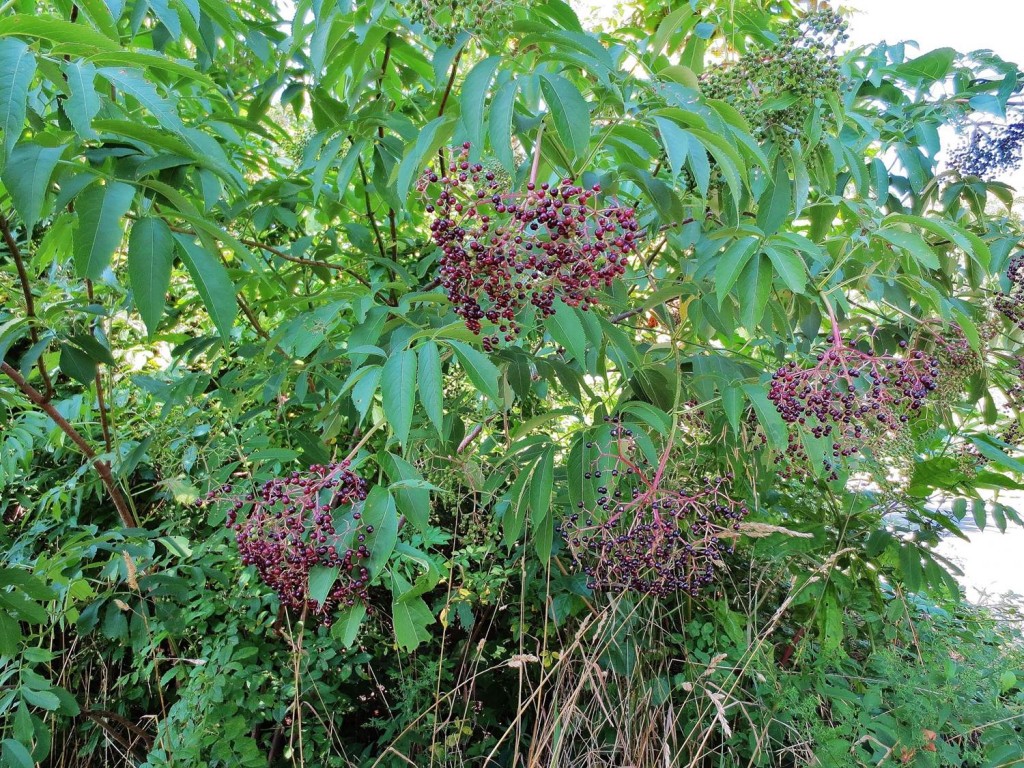
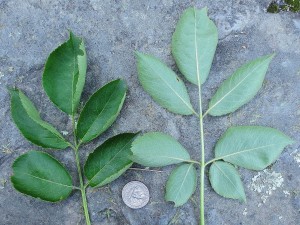
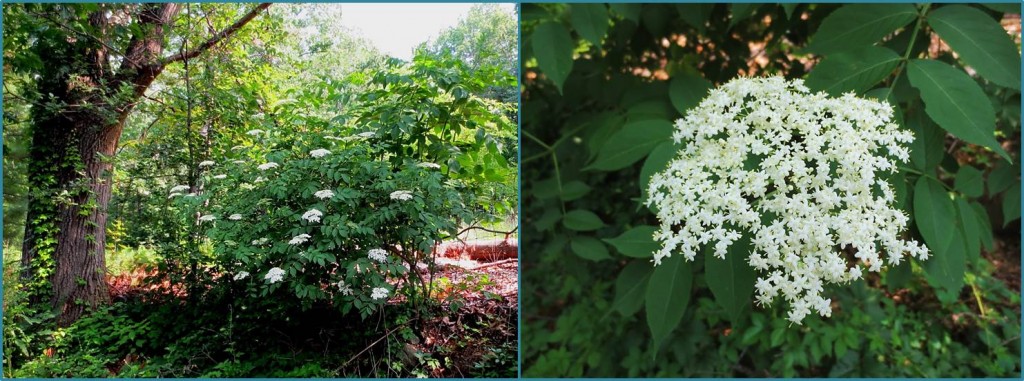
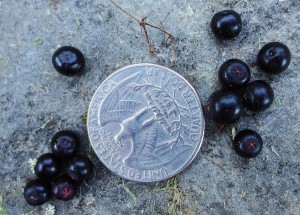
Nice article! Question for you: Do you remove the seeds from your elderberry preparations?
My experience with Elderberry is limited to making tinctures and syrups (seeds removed) of the fruit for medicine.
Josh would you share some of your recipes for tinctures & syrups. I currently make Elderberry wine but I use a different method of stem juicing the berries. I do not pick each berry off their stems I instead bunch them up and cut off as much stem as close to the cluster as possible. My juice comes out a concentrate and I have made a cough syrup by just adding alcohol. I would like more ideas for health benefits.
Thank you! Yes, I do remove seeds, so basically I make juice, syrup, and jelly. I don’t make jam with elderberries because I find the seeds annoying in the jam. I do snack on them raw occasionally when I’m out walking, and don’t mind the seeds then, but I don’t relish the flavor of the raw berries. I’m hoping to post an elderberry recipe in a couple of weeks. I’m away on vacation now, but froze some elderberry syrup just before I left so I can use it when I return.
I may try cooking with the flowers next spring, but I always find it difficult to pick them, not only because I want the berries, but because they are so pretty!
Pingback: Elderberry ice cream with chocolate hazelnut crunch - One Acre Farm
Pingback: Creating a Chicken Habitat with Tips from Jungle Fowl - One Acre Farm
Great post, not many people seem to know about the elderberry but elderberry cordial is some very tasty stuff. Thanks for the very descriptive pictures of the leaves, blossoms and berries they are very helpful when trying to identify the plants.
Thanks for stopping by! I am learning that so many wild plants have edible parts, and you’re right, elderberry is particularly tasty. It is also one of my favorites simply because it is so common and easily accessible where I live.
I am so jealous! I have been searching for an elderberry source for years. Elderberry is the very best thing for my husband’s seasonal allergies. Since we go through so much of the juice I would love to make my own.
Where are you from, May? Elderberry is pretty common over much of North America.
Janet I really enjoyed your article about the Elderberry. It’s one of my favorites and my chickens too, I have to net them up this year s o my hens cant get to them.
Thanks Terri. My chickens love them, too. I sometimes bring bunches of elderberry branches into their yard for them to feast on. It’s a real treat for them.
My cows eat them up! They will literally strip the whole bush!
Thanks for all the information on identification. We have a creek that runs the length of our 10 acres and 15 years ago I noticed the bushes and all the berries. Since I didn’t know what they were I never tried them. I will try them now. Thanks again.
Excellent article. Very informative. I have been foraging throughout CT,MASS,RI area since my early teens and elderberry is my favorite by far. Excellent tasting and easy to make wine and an awesome pie with wild bush blueberries. Syrup is also an essential in my medicine cabinet.
Thanks! It is a very useful plant, and with so many people purchasing dried elderberries these days, I am delighted to be able to pick them fresh practically out the front door. They are abundant here!
You have mentioned several times: where, exactly, is “here”?
I live in Oregon, in the Willamette Valley. Do they grow here?
I included a link to a range map in the section “where to forage for elderberries”. It does not appear that this species is native to Oregon, though it’s possible it has been introduced there. So the answer is that I am not sure whether you will find them there in the wild, or not. I think you do have a closely related elderberry, the blue elderberry, native to Oregon.
Pingback: Seedless Elderberry Apple Jam - One Acre Farm
Pingback: 10 Shrubs for a Wildlife-Friendly, Edible Landscape - One Acre Farm
How do you tell elderberry from Poke weed? Poke is a big ol’ bush with berries the same shape and color as elderberry.
Larry, elderberry is a shrub, which means it is woody. When it drops its leaves in fall, the woody shrub remains standing. Poke, on the other hand, is herbaceous, which means it has no woody parts. It dies back in fall. The leaves and berries of these two plants are actually quite different. Study photos of parts of each species, and you will quickly notice the differences. One obvious difference is that the elderberry clusters are sort of flat or rounded, while pokeberry clusters are long and narrow.
Thanks, Janet, this is extremely helpful! I’ll know now, not to mess with the POKE weed in my back yard, except to use a chain saw on it next time it sprouts. I will have to go look for Elderberry in the woods, tho, sinve my wife swears that it’s one of the few REAL cold fighters there are!
Thanks again!
Oh gosh, finally found something on my favorite berry bush. Have problem finding Elder berries or bushes out in western Canada. Perhaps the climate is too cold? If you know where I can find one or two… please let me know. I Know them well from Scandinavia.
Excellent and healthy. Good for wine flavouring, Gin mix!!, as a watered down juice drink, jelly…….PS. IKEA sell ready mixed “Fläder-Saft” (Elder Flower Concentrate) for drinking or flavouring.
Hi Tom, I don’t think Sambucus canadensis grows in western Canada, but there are probably other species of elderberry there. I don’t know for sure, though, sorry.
Tom ,Surprised you can’t find them in your neck of the woods. I live in Park City , Utah, a ski town at 7,000 ft above sea level and the wild ones are everywhere. I doubt that the cold has anything to do with the scarcity. About 10% are the red variety, they are not as tall as blue species. Have to start harvesting soon…as the deer ,elk ,& moose have already ! Able to pick as many rose hips as I want at the same time , all wild ! YAHOO !
I have seen elderberry growing wild in Prince George British Columbia. There is also a domestic ornamental shrub with edible black berries that is grown here, I believe it is a Nivea elderberry. I also came across some red elderberries growing on mr daughter’s farm near Lacombe Alberta.
Pingback: Save Money on Chicken Feed with Natural, Healthful Alternatives - One Acre Farm
Hi, I too am a homebody but only have 1/2 acre… and am trying to make my place as wonderful as yours sounds… we have the most beautiful Garden in Pleasant Grove, chickens and the cutest hen house over, almost every part of our yard is eatable.. with Raspberries Boisonberries, grapes, cherries, apples, black and english walnuts, herbs of all sorts including stevia, and goji berries. ( and the healthiest birds alive) lol am looking for elderberries… do you sell them? possibly a couple of plants … would you be interested in bartering goji for elderberry plants.? and I am sure you are a wealth of information …. could I if nothing else come visit your haven and learn? Jeanette
Hi Jeanette, I don’t sell elderberry plants because I do not grow them, I forage for them. If you live near me, you should be able to find them easily, because they are common around here. I’m sorry to say I don’t have time to meet with everyone who asks, but I am considering teaching a class here on certain topics, and if I do, I’ll be posting it on this blog, so stay tuned. In any case, it sounds like you yourself are a very experienced backyard farmer, with perhaps more growing in your yard than I have in mine!
Hi Jeanette, how do you Harvest and prepare your black walnuts? I have them on my property and can’t figure out what to do with them! Thanks, Janet
I have been searching the web for an answer to my dilemma. I picked elderberries up the canyon this morning… 3 gals. When I got home and put them in the sink to wash and take off the vine, I noticed that some have redish brown stems and others are on green stems. The berries look and taste the same…I think. They are both bluish color. Could one be poison. I was intending to make jelly. Thanks for any help.
Hello! Thanks for your article. I have been searching my area of SW Michigan for 3 years in hopes of making syrup. Today, I found 5 massive bushes at my sister’s home that I had never noticed. I’m fairly certain now that it is in fact elderberry, but I’m struggling to learn it’s variety. The berries seem more oval that what I have view online. Any thoughts?
The areas people mentioned all seems like Cold Weather areas…I live in Southern California. I have looked. Do they grow here???